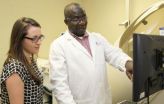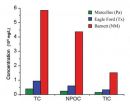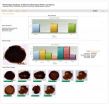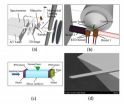(Press-News.org) Spin-charge converters are important devices in spintronics, an electronic which is not only based on the charge of electrons but also on their spin and the spin-related magnetism. Spin-charge converters enable the transformation of electric into magnetic signals and vice versa. Recently, the research group of Professor Jairo Sinova from the Institute of Physics at Johannes Gutenberg University Mainz in collaboration with researchers from the UK, Prague, and Japan, has for the first time realised a new, efficient spin-charge converter based on the common semiconductor material GaAs.
Comparable efficiencies had so far only been observed in platinum, a heavy metal. In addition, the physicists demonstrated that the creation or detection efficiency of spin currents is electrically tunable in a certain regime. This is important when it comes to real devices. The underlying mechanism, that was revealed by theoretical works of the Sinova group, opens up a new approach in searching and engineering spintronic materials. These results have recently been published in the journal Nature Materials.
Spintronics does not only make use of the electron's charge to transmit and store information but it takes also advantage of the electron's spin. The spin can be regarded as a rotation of the electron around its own axis, and generates a magnetic field like a small magnet. In some materials, electron spins spontaneously align their direction, leading to the phenomenon of ferromagnetism which is well known e.g. in iron. Additionally, „spin-up" or „spin-down" directions can be used to represent two easily distinguishable states – 0 and 1 – used in information technology. This is already used for memory applications such as computer hard discs.
Making use of electron spin for information transmission and storage, enables the development of electronic devices with new functionalities and higher efficiency. To make real use of the electron spin, it has to be manipulated precisely: it has to be aligned, transmitted and detected. The work of Sinova and his colleagues shows, that it is possible to do so using electric fields rather than magnetic ones. Thus, the very efficient, simple and precise mechanisms of charge manipulation well established in semiconductor electronics can be transferred to the world of spintronic and thereby combine semiconductor physics with magnetism.
Spin-charge converters are essential tools for that. They can transform charge currents into spin currents, and vice versa. The main principle behind these converters is the so called spin-Hall effect. Jairo Sinova had already been involved in the prediction and discovery of this relativistic phenomenon in 2004.
The spin-Hall effect appears when an electric field drives electrons through a (semi-) conductor plate. Taking a look at the classical Hall effect that is known from undergraduate physics, the interaction of moving electrons and an external magnetic field forces the electrons to move to one side of the plate, perpendicular to their original direction. This leads to the so called Hall voltage between both sides of the plate. For the spin-Hall effect electron-spins are generated by irradiating the sample with circularly polarised light. The electron spins are then parallel or antiparallel, and their direction is perpendicular to the plate and the direction of movement. The moving electron spins are now forced to one or the other side of the plate, depending on the spin orientation. The driving force behind this is the so called spin-orbit coupling, a relativistic electromagnetic effect which influences moving electron spins. This leads to the separation of both spin orientations.
To make practical use of this effect, it is essential to get a highly efficient spin separation. Up to now, platinum has been the most efficient spin-charge converter material, as it is a heavy metal, and the spin-orbit coupling of heavy metals is known to be especially strong due to the large amount of protons (positive charge) in their core.
Now, Sinova and his colleagues have shown that gallium-arsenide (GaAs), a very common and widely used semiconductor material, can be an as efficient spin-charge converter as platinum, even at room temperature, which is important for practical applications. Moreover, the physicists have demonstrated for the first time that the efficiency can be tuned continuously by varying the electric field that drives the electrons.
The reason for this – as theoretical calculations of the Sinova group have shown – lies in the existence of certain valleys in the conduction band of the semiconductor material. One can think of the conduction band and its valleys as of a motor highway with different lanes, each one requiring a certain minimum velocity. Applying a higher electric field enables a transition from one lane to the other.
Since the spin-orbit coupling is different in each lane, a transition also affects the strength of the spin-hall effect. By varying the electric field, the scientists can distribute the electron spins on the different lanes, thus varying the efficiency of their spin-charge converter.
By taking into account the valleys in the conduction band, Sinova and his colleagues open up new ways to find and engineer highly efficient materials for spintronics. Especially, since current semiconductor growth technologies are capable of engineering the energy levels of the valleys and the strength of spin-orbit coupling, e.g. by substituting Ga or As with other materials like Aluminum.
INFORMATION:
Publication:
N. Okamoto, H. Kurebayashi, T. Trypiniotis, I. Farrer, D. A. Ritchie, E. Saitoh, J. Sinova, J. Mašek, T. Jungwirth & C. H. W. Barnes
Electric control of the spin Hall effect by intervalley transitions
Nature Materials, August 2014, doi:10.1038/nmat4059
Further information:
Professor Dr. Jairo Sinova
Institute of Physics
Johannes Gutenberg University Mainz (JGU)
55099 Mainz, GERMANY
phone +49 6131 39-21284
fax +49 6131 39-26267
e-mail: sinova@uni-mainz.de
A new, tunable device for spintronics
An international team of scientists including physicist Jairo Sinova from the University of Mainz realises a tunable spin-charge converter made of GaAs
2014-08-28
ELSE PRESS RELEASES FROM THIS DATE:
New analysis of old HIV vaccines finds potentially protective immune response
2014-08-28
DURHAM, N.C. – Applying the benefit of hindsight, researchers at Duke Medicine have reanalyzed the findings of two historic pediatric HIV vaccine trials with encouraging results. The vaccines had in fact triggered an antibody response -- now known to be associated with protection in adults -- that was previously unrecognized in the infants studied in the 1990s.
Reporting online Aug. 28, 2014, in the Journal of Infectious Diseases, the Duke researchers relied on fresh insights that have been gleaned from a recent adult HIV vaccine trial in which the vaccine reduced the ...
New tool aids stem cell engineering for medical research
2014-08-28
ROCHESTER, Minn. — A Mayo Clinic researcher and his collaborators have developed an online analytic tool that will speed up and enhance the process of re-engineering cells for biomedical investigation. CellNet is a free-use Internet platform that uses network biology methods to aid stem cell engineering. Details of CellNet and its application to stem cell engineering are described in two back-to-back papers in the journal Cell.
"This free platform has a broad range of uses for all types of cell-based investigations and can potentially offer help to people working on all ...
UMN researchers find animal model for understudied type of muscular dystrophy
2014-08-28
MINNEAPOLIS/ST. PAUL (August 28, 2014) – Researchers at the University of Minnesota have developed an animal research model for facioscapulohumeral muscular dystrophy (FSHD) to be used for muscle regeneration research as well as studies of the effectiveness of potential therapies for FSHD.
The research is published in the current edition of the journal Cell Reports.
There is no treatment for FSHD, which is thought by many to be the most common type of muscular dystrophy. FSHD is an unusual genetic disorder because, unlike most genetic diseases, it is not caused by the ...
Breastfeeding study shows need for effective peer counseling programs
2014-08-28
Athens, Ga. – The support of peer groups and clinicians is critical to the development of effective breastfeeding programs, according to recent University of Georgia research.
A qualitative study of 21 mothers in the Athens-Clarke County area determined that role models for successful breastfeeding help positively shape the outcomes of mothers of infants.
"Mothers who received that support are more likely to be successful at breastfeeding," said study co-author Alex Anderson, an associate professor in the College of Family and Consumer Sciences department of foods and ...
New solutions needed to recycle fracking water
2014-08-28
HOUSTON – (Aug. 28, 2014) – Rice University scientists have produced a detailed analysis of water produced by hydraulic fracturing (aka fracking) of three gas reservoirs and suggested environmentally friendly remedies are needed to treat and reuse it.
More advanced recycling rather than disposal of "produced" water pumped back out of wells could calm fears of accidental spillage and save millions of gallons of fresh water a year, said Rice chemist Andrew Barron, who led the study that appeared this week in the Royal Society of Chemistry journal Environmental Science: ...
Females ignored in basic medical research
2014-08-28
CHICAGO --- A new study from Northwestern Medicine® has found that surgical researchers rarely use female animals or female cells in their published studies -- despite a huge body of evidence showing that sex differences can play a crucial role in medical research.
Editors of the five major surgical journals reviewed in this study have responded to this finding and will now require authors to state the sex of animals and cells used in their studies. If they use only one sex in their studies, they will be asked to justify why.
"Women make up half the population, but ...
UTHealth researchers find up to 3,000 times the bacterial growth on hollow-head toothbrushes
2014-08-28
HOUSTON – (Aug. 28, 2014) — Solid-head power toothbrushes retain less bacteria compared to hollow-head toothbrushes, according to researchers at The University of Texas Health Science Center at Houston (UTHealth) School of Dentistry.
The results of the study are published in the August issue of the Journal of Dental Hygiene. Lead author and professor at the UTHealth School of Dentistry, Donna Warren Morris, R.D.H., M.Ed., notes that microbial counts were lower in the solid-head toothbrush group than in the two hollow-head toothbrush groups in 9 out of 10 comparisons.
"Toothbrushes ...
Together, humans and computers can figure out the plant world
2014-08-28
As technology advances, science has become increasingly about data—how to gather it, organize it, and analyze it. The creation of key databases to analyze and share data lies at the heart of bioinformatics, or the collection, classification, storage, and analysis of biochemical and biological information using computers and software. The tools and methods used in bioinformatics have been instrumental in the development of fields such as molecular genetics and genomics. But, in the plant sciences, bioinformatics and biometrics are employed in all fields—not just genomics—to ...
New analytical technology reveals 'nanomechanical' surface traits
2014-08-28
WEST LAFAYETTE, Ind. – A new research platform uses a laser to measure the "nanomechanical" properties of tiny structures undergoing stress and heating, an approach likely to yield insights to improve designs for microelectronics and batteries.
This new technique, called nanomechanical Raman spectroscopy, reveals information about how heating and the surface stress of microscale structures affect their mechanical properties. Researchers have discussed the merits of surface-stress influence on mechanical properties for decades. However, the nanomechanical Raman spectroscopy ...
Sensory-tested drug-delivery vehicle could limit spread of HIV, AIDS
2014-08-28
A unique method for delivering compounds that could positively impact the global battle against HIV and AIDS may be possible, thanks to researchers in Penn State's College of Agricultural Sciences.
A semi-soft vaginal suppository made from the seaweed-derived food ingredient carrageenan and loaded with the antiviral drug Tenofovir provides a woman-initiated, drug-delivery vehicle that can protect against the spread of sexually transmitted infections during unprotected heterosexual intercourse, the researchers said.
With more than 34 million people worldwide living with ...
LAST 30 PRESS RELEASES:
Superradiant spins show teamwork at the quantum scale
Cleveland Clinic Research links tumor bacteria to immunotherapy resistance in head and neck cancer
First Editorial of 2026: Resisting AI slop
Joint ground- and space-based observations reveal Saturn-mass rogue planet
Inheritable genetic variant offers protection against blood cancer risk and progression
Pigs settled Pacific islands alongside early human voyagers
A Coral reef’s daily pulse reshapes microbes in surrounding waters
EAST Tokamak experiments exceed plasma density limit, offering new approach to fusion ignition
Groundbreaking discovery reveals Africa’s oldest cremation pyre and complex ritual practices
First breathing ‘lung-on-chip’ developed using genetically identical cells
How people moved pigs across the Pacific
Interaction of climate change and human activity and its impact on plant diversity in Qinghai-Tibet plateau
From addressing uncertainty to national strategy: an interpretation of Professor Lim Siong Guan’s views
Clinical trials on AI language model use in digestive healthcare
Scientists improve robotic visual–inertial trajectory localization accuracy using cross-modal interaction and selection techniques
Correlation between cancer cachexia and immune-related adverse events in HCC
Human adipose tissue: a new source for functional organoids
Metro lines double as freight highways during off-peak hours, Beijing study shows
Biomedical functions and applications of nanomaterials in tumor diagnosis and treatment: perspectives from ophthalmic oncology
3D imaging unveils how passivation improves perovskite solar cell performance
Enriching framework Al sites in 8-membered rings of Cu-SSZ-39 zeolite to enhance low-temperature ammonia selective catalytic reduction performance
AI-powered RNA drug development: a new frontier in therapeutics
Decoupling the HOR enhancement on PtRu: Dynamically matching interfacial water to reaction coordinates
Sulfur isn’t poisonous when it synergistically acts with phosphine in olefins hydroformylation
URI researchers uncover molecular mechanisms behind speciation in corals
Chitin based carbon aerogel offers a cleaner way to store thermal energy
Tracing hidden sources of nitrate pollution in rapidly changing rural urban landscapes
Viruses on plastic pollution may quietly accelerate the spread of antibiotic resistance
Three UH Rainbow Babies & Children’s faculty elected to prestigious American Pediatric Society
Tunnel resilience models unveiled to aid post-earthquake recovery
[Press-News.org] A new, tunable device for spintronicsAn international team of scientists including physicist Jairo Sinova from the University of Mainz realises a tunable spin-charge converter made of GaAs




